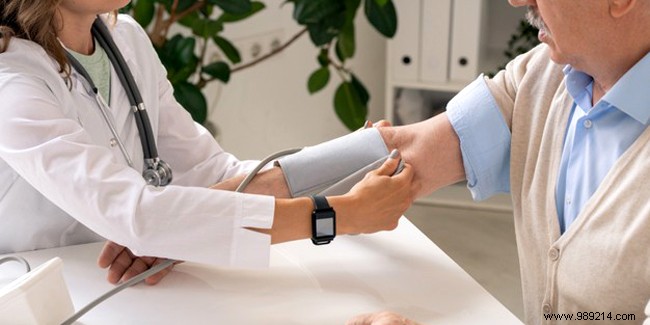
Blood pressure measures the pressure that blood exerts on the walls of our arteries. This examination is systematically carried out by doctors during a visit to their office in order to detect possible high blood pressure, the main factor in heart disease and strokes, which are the leading causes of death in the world. . You can also measure your blood pressure yourself. We tell you everything about what is hidden behind this measurement and how to interpret it.
Blood pressure refers to the pressure with which the blood circulates in our arteries, and more precisely the pressure exerted by the blood on the arteries. This pressure is linked to what is called the cardiac cycle punctuated by the movements of our heart which in fact acts as a real pump to irrigate our body with blood. Our heart contracts between 50 and 80 times per minute when we are at rest, and much more during an effort or a strong emotion.
When the arterial walls are under tension due to this cardiac cycle, it allows our blood to circulate well and reach all parts of our body thanks to our arteries which also contract and all our capillaries (our deepest blood vessels). purposes).
Blood pressure is used to interpret the risks at the origin of cardiovascular diseases to which a person may be exposed, such as high blood pressure, diabetes, or even excess cholesterol.
Blood pressure is measured at the level of an arm using, if it is a health professional who performs it, two types of electrical devices, a tensiometer or an ambulatory blood pressure measuring device (ABPM). ) that must be worn continuously for 24 hours because it automatically measures blood pressure every 15 minutes. These devices measure blood pressure and translate it into two numbers expressed in millimeters of mercury (mmHg).
But the measurement of blood pressure can also be carried out by each person at home. We then speak of blood pressure self-measurement. The latter can in particular be recommended by the doctor to obtain several measurements at different times of the day, but also for people who show high blood pressure just because their blood pressure is measured by a doctor, therefore due to a strong emotion, a scared, at that time.
To measure your blood pressure yourself, it is advisable to use a blood pressure monitor with a cuff that is placed on the arm, rather than a device that is positioned on the wrist.
In all cases, the measurement of his blood pressure must comply with specific rules. We talk about respecting the “rule of 3”:
On the other hand, measuring your blood pressure yourself requires respecting certain conditions:5 minutes before the measurement, you must sit quietly; place the arm where the measurement will be taken, slightly bent on a table, with the elbow at chest level; place the blood pressure cuff on a bare arm; once the device is on (the cuff inflates and deflates automatically), do not speak, move or clench your fist.
Our blood pressure is not the same all day. It varies according to our activities:it lowers during our phases of sleep and rest and rises when we provide efforts or when we are confronted with strong emotions.
In the same way, temperatures cause our blood pressure to vary, which drops with heat and rises with cold.
However, a standard is defined to qualify a “normal” blood pressure:it must be 120/80, a measurement expressed in millimeters of mercury (mmHg). 120 corresponds to a maximum pressure (called systolic pressure), the moment when our heart contracts to empty the blood that it contains. 80 designates, on the other hand, the minimum pressure (the diastolic pressure), when the heart relaxes to fill.
Beyond a blood pressure of 140/90, if it is measured in the medical environment, or 135/85, if it is a measurement carried out by the patient himself, we speak of arterial hypertension with higher risks of declaring a cardiovascular disease.